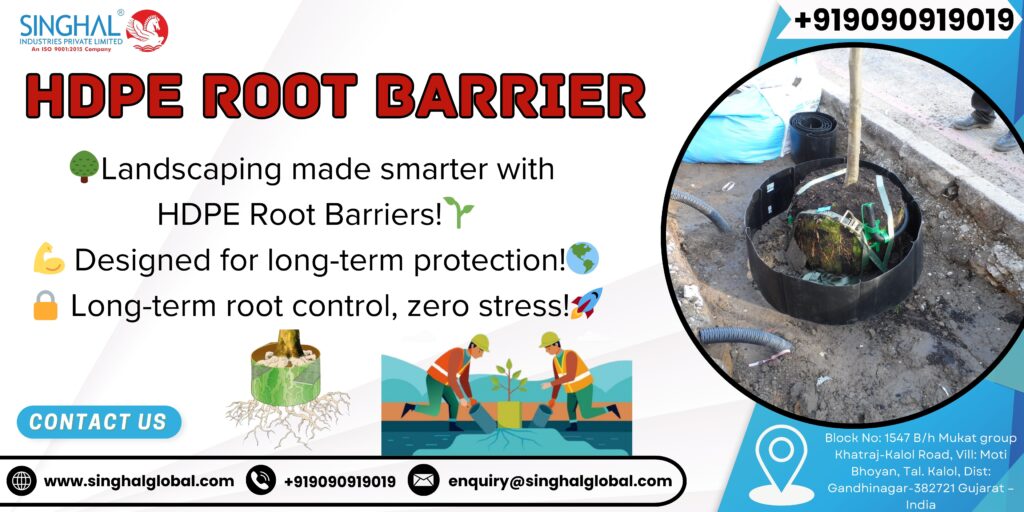Preventing tree roots from growing too far is important in architecture and city planning for green reasons and to protect the infrastructure. Many architects, urban planners and homeowners now prefer to use the root barriers manufacturers. These barriers are useful because they both separate plants and help manage roots for a long time.
Because cities are growing and parks are shrinking, trees are set up next to guides, walkways, utility pipes and even underground systems. Without proper management of roots, they may get inside these structures and do extensive damage. For this reason, people use HDPE root barriers.
What is an HDPE Root Barrier?
HDPE (High-Density Polyethylene) is a plastic sheet made to be strong and resistance to chemicals; it helps divert tree roots from areas sensitive to their growth. They are designed to be sturdy, bending with the soil, plus long-lasting which makes them a cost-saving method against underground root intrusion.
With Root barriers manufacturers improving the soil barriers, the preference for HDPE roots barriers has increased because they are sturdy, suitable in nature and not very difficult to put in place. Compared to concrete or metal barriers, HDPE barriers are easier to install, more lightweight and also better at deflecting roots.
Benefits of Using HDPE Root Barriers
1. Protect Infrastructure
Pavements, sidewalk slabs and pipes can all be damaged by growing tree roots. Putting in HDPE root barriers redirects roots to run away from things like sidewalks and pipes. It supports the continued stability of roads, the foundation and systems of underground pipes.
2. Preserve Trees Without Compromise
They both enhance tree well-being and shield the foundation of a building. Root barriers allow the roots to remain contained and safe for your house, unlike with cutting down trees that might cause foundation issues. Healthy deep rooting as a result creates a stronger and more stable tree.
3. Cost-Efficient Root Management
Fixing cracks in concrete or repairing damaged plumbing costs much more than the Root barrier price. Interest in root barrier installation can prevent thousands of dollars in future maintenance costs.
4. Environmental and Chemical Resistance
HDPE root barriers stand up to the effects of soil chemicals, humidity and chemicals in roots. As a result, they suit use deep underground, regardless of the environment. Those insecticides, being non-toxic, do not harm the environment and allow the plants around it to flourish.
Applications of Plastic Root Barriers
HDPE root barriers serve many sectors and applications such as:
- Residential Landscapes: Stop roots from growing in and around gardens, lawns, driveways and patios.
- Municipal Infrastructure: Preserve sidewalks, paths and the materials used for public utilities.
- Agricultural and Nursery Use: Put each root zone into a separate area in plantations or tree farms.
The availability of root barriers manufacturers across India, so implementing these systems is accessible in all kinds of projects.
Choosing the Right HDPE Root Barrier
Selecting a root barrier requires thinking about:
- Thickness: Can vary between 1 and 2 millimeters, depending on the type of a root and the type of soil.
- Height: Vertical supports should be taller (e.g., 24-48 inches) for trees that are bigger and have deeper roots.
- Perforated vs. Solid: Limited water and airflow happens with perforated fabric, but solid fabric sheets provide the greatest protection.
It is also helpful to talk to local suppliers to find the right specification. Most root barrier companies can make custom orders and give discounts for larger projects.
How to Install HDPE Root Barriers
Understanding installation methods is necessary for an effective root redirection. The steps are explained simply below.
- Trench Preparation: Dig a trench along the spot to be protected, so it can support the height of your barrier.
- Insert the Barrier: Put the HDPE sheet in the trench so that the smooth and flat side is facing the tree (this helps block the roots from getting through).
- Secure the Edges: Joint the edges of the barrier together and hold it in place to stop gaps from occurring for root growth.
- Backfill: Stuff compact soil into the trench as you lift the barrier so it stays upright in place.
HDPE barriers can bend around corners or curves which makes them especially fit for many different types of landscapes.
Many people are turning to leading Plastic root barrier solutions because they are both strong and affordable. Since root barrier price have become competitive, people are choosing these products to help achieve a lasting balance between trees and their properties. With more root barriers manufacturers in the country, there is no worry for reliable access to root barriers for any project, great or small.
Why HDPE Root Barriers Are the Future of Urban Landscaping
Because sustainability is important now, HDPE root barriers provide an eco-friendly solution to root problems. They help guard structures from damage and at the same time look after the well-being of trees and plants in the city. For city planners concerned about protecting their cables and for those of us with cracked driveways, these barriers give us confidence and good results over time.
As understanding of their benefits expands, more people need superior plastic root barriers. With lower root barrier prices and a growing number of trusted manufacturers, choosing HDPE root barriers makes sound sense for all who look for solid root management.
Conclusion
Managing tree roots in both cities and nature has been improved by HDPE root barriers. As a result of preventing root damage such barriers both save money and help keep trees and surrounding buildings intact. With strong support from good root barrier manufacturers, setting up proper root control is simpler and more inexpensive.
Protecting your yard and the environment rationally can both be done by choosing HDPE root barriers.
Frequently Asked Questions (FAQs)
Q.1 Can HDPE root barriers stop invasive roots?
Yes, HDPE root barriers are created to stop strong or invasive roots from reaching places they should not. Having a physical border causes roots to grow away and not harm important parts of the garden.
Q.2 Can root barriers protect sidewalks and pipes?
Absolutely. HDPE root barriers are often used to defend underground pipes, sidewalks and driveways from roots. Because roots can put a lot of pressure on these devices and potentially intrude, barriers are a good protection.
Q.3 Does HDPE root barrier stop all root development?
If you have HDPE barriers, roots will be able to grow normally. Rather, these guide roots so that they grow safely away from infrastructure.
Q.4 Will root barriers affect tree health?
Not negatively. They actually support the development of stronger roots, making trees less likely to blow over or get damaged by droughts. An installed barrier won’t stop trees from growing if it is put up correctly and will make city landscapes more attractive.









